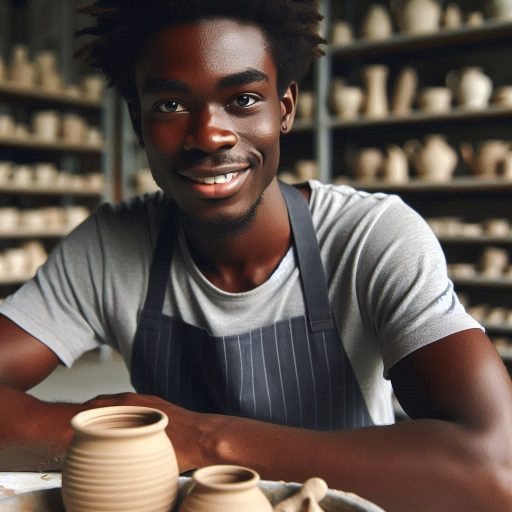Introduction
A strong printmaking portfolio is essential for every artist.
It serves as a visual resume, showcasing your skills and artistic vision.
A well-curated portfolio highlights your best work and demonstrates your proficiency in various printmaking techniques.
It’s a powerful tool for attracting potential clients and securing gallery opportunities.
Having a polished portfolio can open doors to new professional prospects.
It allows artists to present their work in a structured, coherent manner.
A well-organized collection helps you make a lasting impression on galleries and potential buyers.
It shows that you are serious about your craft and committed to your artistic career.
Your portfolio should include a diverse range of printmaking pieces.
This diversity showcases your versatility and technical skills.
It should highlight both your strengths and your unique artistic style.
Including different techniques, subjects, and formats can make your portfolio more engaging and comprehensive.
Moreover, a strong portfolio helps in networking and self-promotion.
It acts as a visual summary of your artistic journey.
When meeting with galleries or clients, a well-presented portfolio can effectively communicate your artistic vision and capabilities.
It also provides a tangible reference for discussions about potential projects or exhibitions.
In essence, a printmaking portfolio is more than just a collection of work.
It is a crucial element of your professional identity.
It helps you stand out in a competitive field and can significantly influence your career opportunities.
Building a strong portfolio should be a priority for any printmaker aiming to advance their career.
Transform Your Career Today
Unlock a personalized career strategy that drives real results. Get tailored advice and a roadmap designed just for you.
Start NowDefine the purpose of the portfolio
The primary goal of a printmaking portfolio, which is to showcase a range of work that highlights the artist’s skills and style
A printmaking portfolio is a vital tool for any artist.
Its primary goal is to showcase a range of work, highlighting both skill and style.
This collection of prints should reflect your artistic journey and demonstrate your technical prowess.
The importance of selecting pieces that represent the artist’s unique voice and expertise in the field of printmaking
Selecting the right pieces is crucial.
Choose works that showcase your unique voice.
This means including prints that not only display your technical abilities but also reveal your creative vision.
The portfolio should act as a visual resume, offering a glimpse into your artistic identity and capabilities.
When curating your portfolio, consider the diversity of techniques used.
Include prints that exhibit different methods, such as etching, lithography, or screen printing.
This variety will illustrate your versatility and mastery of the medium.
Moreover, aim to present a cohesive body of work.
Each piece should connect to the others, creating a narrative that underscores your artistic evolution.
Avoid including random or unrelated prints, as they can dilute the impact of your portfolio.
Highlighting your unique voice is essential.
Your portfolio should reflect your individual approach and creative perspective.
This personal touch distinguishes you from other artists and makes your work memorable.
In summary, your printmaking portfolio should serve as a comprehensive showcase of your skills and style.
It should represent your artistic journey, highlight your technical abilities, and express your unique voice.
By carefully selecting and presenting your best work, you create a powerful tool for opportunities and professional growth.
Transform Your Career Today
Unlock a personalized career strategy that drives real results. Get tailored advice and a roadmap designed just for you.
Start NowRead: How to Price Your Character Design Work as a Freelancer
Selecting the Right Pieces
When building a printmaking portfolio, selecting the right pieces is crucial for showcasing your skills and artistic vision.
Here’s how to choose effectively.
Criteria for Choosing Pieces
Start by focusing on variety. Include different printmaking techniques to show your versatility.
For instance, if you work with etching, screen printing, and lithography, display examples of each.
This demonstrates your broad skill set.
Next, emphasize quality.
Choose pieces that reflect your best work.
Avoid including anything that doesn’t meet your highest standards.
Each print should showcase your attention to detail and commitment to craftsmanship.
Relevance to your goals is also key.
Select prints that align with the direction you want your career to take.
If you aim to work in contemporary art galleries, include pieces that fit that aesthetic.
Ensure your selections represent your personal style and artistic vision.
Demonstrating Technical Proficiency
Showcase your technical skills by including prints that highlight your mastery of printmaking techniques.
For example, include a piece that demonstrates your ability to control line quality and texture.
Highlight complex prints that involve multiple colors or intricate details.
Choose pieces where you’ve applied advanced techniques or solved technical challenges.
This not only proves your proficiency but also your problem-solving abilities.
Ensure that each piece is well-executed and free of technical flaws.
Transform Your Career Today
Unlock a personalized career strategy that drives real results. Get tailored advice and a roadmap designed just for you.
Start NowCreativity and Consistency
Select pieces that illustrate your creativity.
Include work that showcases original concepts and innovative approaches.
This helps potential clients or employers see your unique artistic voice.
Maintain consistency in style.
Your portfolio should reflect a cohesive body of work.
Avoid mixing vastly different styles unless you are trying to show a range of capabilities.
Consistency in style helps create a clear and memorable impression.
In fact, when selecting pieces for your printmaking portfolio, prioritize variety, quality, and relevance.
Demonstrate technical proficiency, creativity, and consistency.
A well-curated portfolio will effectively communicate your skills and artistic identity.
Read: Top Printmaking Tools for Beginners
Organizing Your Printmaking Portfolio
Creating an effective printmaking portfolio involves thoughtful organization.
Follow these best practices to present your work clearly and professionally.
Create a Cohesive Layout
Start by designing a cohesive layout for your portfolio.
Consistency in presentation helps viewers navigate your work easily.
Arrange your prints in a logical order, such as by technique or theme.
Use a clean, uncluttered design to highlight your prints without distraction.
Ensure that each piece is presented in a way that complements the others.
Group Similar Pieces Together
Grouping similar pieces together enhances the overall impact of your portfolio.
Categorize prints by technique, subject matter, or series.
Transform Your Career Today
Unlock a personalized career strategy that drives real results. Get tailored advice and a roadmap designed just for you.
Start NowThis organization shows your depth and skill in specific areas, making it easier for viewers to appreciate your expertise.
For instance, place all intaglio prints or all abstract works in separate sections.
Provide Context for Each Artwork
Include a brief description or context for each print.
Explain the technique used, the inspiration behind the work, or any relevant details.
Providing context helps viewers understand your creative process and the story behind each piece.
This additional information adds depth to your portfolio and engages your audience more effectively.
Include a Variety of Work
Showcase a diverse range of work to demonstrate your versatility.
Include prints of different techniques, sizes, and subject matters.
This variety highlights your adaptability and broad skill set.
By presenting multiple approaches and styles, you cater to different tastes and increase your portfolio’s appeal to a wider audience.
An organized printmaking portfolio showcases your skills effectively.
A cohesive layout, grouped pieces, and contextual information all contribute to a professional presentation.
Including a variety of work further emphasizes your versatility and range.
Follow these guidelines to build a portfolio that impresses and engages your audience.
Read: Character Design Workshops: Benefits and Opportunities

Documenting the Work
When building a printmaking portfolio, documenting your work accurately is crucial.
High-quality images are the first impression potential viewers have of your prints.
They serve as a visual introduction to your artistic skills and style.
Therefore, investing time in capturing these images is essential for making a positive impact.
Significance of High-Quality Images
High-quality images are vital in a printmaking portfolio.
Transform Your Career Today
Unlock a personalized career strategy that drives real results. Get tailored advice and a roadmap designed just for you.
Start NowThey ensure that viewers see your work as intended.
Clear, sharp images showcase the details and textures of your prints.
They also capture the true colors, which is crucial for representing your artistic vision.
Inconsistent or poor-quality images can misrepresent your work and affect how it’s perceived.
High-resolution photos allow for a true representation of your technique and creativity.
Tips for Photographing Prints
- Lighting: Use diffused, natural light to avoid harsh shadows and glare.
Position your prints near a large window with indirect sunlight.
For consistent results, consider using softbox lighting or daylight bulbs. - Angles: Photograph prints from a straight-on angle to avoid distortion.
Ensure the entire print is captured in the frame.
Tilted or skewed images can mislead viewers about the actual appearance of the work. - Resolution: Use a high-resolution setting on your camera to capture fine details.
This ensures that viewers can see intricate aspects of your prints.
Low-resolution images can look blurry or pixelated, diminishing the impact of your work. - Background: Use a neutral, non-reflective background to keep the focus on your print.
Avoid backgrounds that can distract or interfere with the artwork’s presentation. - Editing: Post-process images to correct colors and adjust brightness if necessary.
Ensure that edits enhance the image without altering the actual appearance of the print.
By adhering to these tips, you’ll create a compelling, professional portfolio that accurately represents your printmaking skills and artistry.
Read: Incorporating Cultural Elements in Character Design
Crafting an Artist Statement
An artist statement is a vital component of your printmaking portfolio.
It provides insight into your creative process, influences, and artistic goals.
A compelling statement can captivate viewers and help them connect with your work.
Guide Artists on Writing a Compelling Artist Statement
Start by describing your creative process.
Explain how you approach printmaking, including techniques and materials you use.
Discuss what inspires your work.
This could be personal experiences, cultural influences, or artistic movements.
Clarify your artistic goals.
What do you aim to express through your prints? Your statement should convey your passion and vision clearly and concisely.
Use engaging language to draw readers in.
Avoid jargon and keep the tone authentic.
Offer Tips on Tailoring the Artist Statement
Align your artist statement with the style and theme of your portfolio.
If your prints are abstract, your statement should reflect this by discussing your approach to abstraction.
Transform Your Career Today
Unlock a personalized career strategy that drives real results. Get tailored advice and a roadmap designed just for you.
Start NowIf your work is figurative, focus on how you interpret subjects.
Consider the overall mood and message of your portfolio.
Ensure your statement complements these elements and enhances understanding.
Tailor your language to match the tone of your prints, whether it’s vibrant and energetic or calm and contemplative.
Additionally, keep your statement brief and impactful.
Aim for a few paragraphs that convey essential information without overwhelming the reader.
Revisit and revise your statement regularly to reflect any evolution in your work.
In summary, a well-crafted artist statement enhances your printmaking portfolio.
It bridges the gap between your creative vision and the viewer’s experience.
By clearly articulating your process, influences, and goals, and tailoring your statement to match your portfolio’s style, you create a powerful narrative that resonates with your audience.
Seeking feedback and revisions
Encourage artists to seek feedback from peers, mentors, or professionals in the field to get constructive criticism on their portfolio
Building a compelling printmaking portfolio involves more than just showcasing your best work.
It’s crucial to seek feedback from peers, mentors, or professionals.
Constructive criticism can provide fresh perspectives and highlight areas needing improvement.
Artists should actively reach out to individuals with experience in the field.
These critiques offer valuable insights into how your portfolio might be perceived by others.
Engage with your network by sharing your portfolio and requesting honest opinions.
Be open to feedback, even if it feels uncomfortable.
Remember, the goal is to refine your work and enhance its impact.
Constructive criticism is a tool for growth, not a personal attack.
Transform Your Career Today
Unlock a personalized career strategy that drives real results. Get tailored advice and a roadmap designed just for you.
Start NowTake note of recurring themes in the feedback you receive, as these often indicate areas that need attention.
Recommend making revisions based on feedback to improve the overall quality and cohesiveness of the portfolio
Once you gather feedback, it’s time to make revisions.
Revisit your portfolio with a critical eye and incorporate suggested changes.
Focus on improving aspects like layout, presentation, and the clarity of your artistic vision.
Revisions might involve rearranging prints, refining descriptions, or enhancing visual consistency.
It’s essential to view revisions as an opportunity to elevate your portfolio’s quality and cohesiveness.
A well-revised portfolio will better reflect your artistic strengths and vision.
Regularly update your portfolio to keep it relevant and aligned with your evolving style.
By seeking feedback and making thoughtful revisions, you ensure your portfolio remains dynamic and engaging.
This process not only improves the overall presentation but also demonstrates your commitment to continuous improvement.
Embrace feedback as a valuable part of your artistic journey and use it to create a standout printmaking portfolio.
Conclusion
Building a strong printmaking portfolio is crucial for artists seeking recognition and opportunities.
It is essential to showcase a variety of techniques and styles in your portfolio to demonstrate your versatility and skill.
Additionally, including well-documented processes and concept development helps to give insight into your creative journey.
Encourage readers to start crafting their portfolios by following the outlined steps in this blog post.
Remember to continuously refine and update your work as you grow and develop as an artist.
Building a strong printmaking portfolio takes time and effort, but the end result can open doors to new opportunities and collaborations in the art world.
Start building your portfolio today and watch your artistic career soar!




